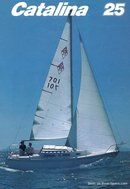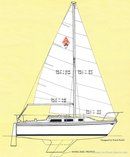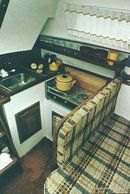Catalina 25 Swing keel
Sailboat specifications
The Catalina 25 is a 25’ (7.62m) cruising sailboat designed by Frank Butler (United States). She was built between 1978 and 1994 by Catalina Yachts (United States) with 5866 hulls completed. The Swing keel version adopts an appendage configuration without compromise between draft and performance. The only drawbacks are the space taken inside and the price of the system...
The Catalina 25 is as well listed, on Boat-Specs.com, in Fin keel, Wing keel and Tall rig version (see all the versions compared).
The Catalina 25 is as well listed, on Boat-Specs.com, in Fin keel, Wing keel and Tall rig version (see all the versions compared).
Catalina 25's main features
- Model
- Catalina 25
- Version
- Swing keel
- Hull type
- Monohull
- Category
- Cruising sailboat
- Sailboat builder
- Sailboat designer
- Country
- United States
- Construction
- Hull and deck: GRP (glass reinforced polyester)
- Number of hulls built
- 5866
- First built hull
- 1978
- Last built hull
- 1994
- Appendages
- Lifting keel : swing keel
- Helm
- Single tiller
- Rudder
- Single transom hung rudder
- Unsinkable
- No
- Trailerable
- No
- Standard public price ex. VAT (indicative only)
- N/A €
Catalina 25's main dimensions
- Hull length
- 25’7.62 m
- Waterline length
- 22’ 2”6.76 m
- Beam (width)
- 8’2.44 m
- Draft
- 5’1.52 m
- Draft when appendages up
- 2’ 8”0.81 m
- Light displacement (MLC)
- 4149 lb1882 kg
- Ballast weight
- 1499 lb680 kg
Catalina 25's rig and sails
- Upwind sail area
- 270 ft²25.08 m²
- IiFore triangle height (from mast foot to fore stay top attachment)
- 29’8.84 m
- JiFore triangle base (from mast foot to bottom of forestay)
- 10’ 6”3.2 m
- PiMainsail hoist measurement (from tack to head)
- 24’ 8”7.52 m
- EiMainsail foot measurement (from tack to clew)
- 9’ 8”2.95 m
- Rigging type
- Sloop Marconi masthead
- Mast configuration
- Deck stepped mast
- Rotating spars
- No
- Number of levels of spreaders
- 1
- Spreaders angle
- 0 °
- Spars construction
- Aluminum spars
- Standing rigging
- 1x19 strand wire continuous
Catalina 25's performances
- Upwind sail area to displacementiThe ratio sail area to displacement is obtained by dividing the sail area by the boat's displaced volume to the power two-thirds.
The ratio sail area to displacement can be used to compare the relative sail plan of different sailboats no matter what their size.
Upwind: under 18 the ratio indicates a cruise oriented sailboat with limited performances especially in light wind, while over 25 it indicates a fast sailboat. - 177 ft²/T16.45 m²/T
- Displacement-length ratio (DLR)iThe Displacement Length Ratio (DLR) is a figure that points out the boat's weight compared to its waterline length. The DLR is obtained by dividing the boat's displacement in tons by the cube of one one-hundredth of the waterline length (in feet).
The DLR can be used to compare the relative mass of different sailboats no matter what their length:
a DLR less than 180 is indicative of a really light sailboat (race boat made for planning), while a DLR greater than 300 is indicative of a heavy cruising sailboat. - 173
- Ballast ratioiThe Ballast ratio is an indicator of stability; it is obtained by dividing the boat's displacement by the mass of the ballast. Since the stability depends also of the hull shapes and the position of the center of gravity, only the boats with similar ballast arrangements and hull shapes should be compared.
The higher the ballast ratio is, the greater is the stability. - 36 %
- Critical hull speediAs a ship moves in the water, it creates standing waves that oppose its movement. This effect increases dramatically the resistance when the boat reaches a speed-length ratio (speed-length ratio is the ratio between the speed in knots and the square root of the waterline length in feet) of about 1.2 (corresponding to a Froude Number of 0.35) . This very sharp rise in resistance, between speed-length ratio of 1.2 to 1.5, is insurmountable for heavy sailboats and so becomes an apparent barrier. This leads to the concept of "hull speed".
The hull speed is obtained by multiplying the square root of the waterline length (in feet) by 1.34. - 6.31 knots
Catalina 25's auxiliary engine
- Engine(s)
- 1 outboard engine
Catalina 25's accommodations and layout
- Cockpit
- Closed aft cockpit
- Cabin(s)
- 1
- Berth(s) (min./max.)
- 3 / 4
- Head(s)
- 1


Catalina Yachts Catalina 25 - - 1/7
Picture extracted from the commercial documentation © Catalina Yachts
Picture extracted from the commercial documentation © Catalina Yachts


Catalina Yachts Catalina 25 sailplan - - 2/7
Picture extracted from the commercial documentation © Catalina Yachts
Picture extracted from the commercial documentation © Catalina Yachts


Catalina Yachts Catalina 25 layout - - 3/7
Picture extracted from the commercial documentation © Catalina Yachts
Picture extracted from the commercial documentation © Catalina Yachts


Catalina Yachts Catalina 25 layout - - 4/7
Picture extracted from the commercial documentation © Catalina Yachts
Picture extracted from the commercial documentation © Catalina Yachts


Catalina Yachts Catalina 25 interior and accommodations - - 5/7
Picture extracted from the commercial documentation © Catalina Yachts
Picture extracted from the commercial documentation © Catalina Yachts


Catalina Yachts Catalina 25 interior and accommodations - - 6/7
Picture extracted from the commercial documentation © Catalina Yachts
Picture extracted from the commercial documentation © Catalina Yachts


Catalina Yachts Catalina 25 interior and accommodations - - 7/7
Picture extracted from the commercial documentation © Catalina Yachts
Picture extracted from the commercial documentation © Catalina Yachts
Similar sailboats that may interest you:
Sailboats
First built hull
Hull length
1977
25’ 1”7.65 m
1984
25’ 7”7.8 m
1977
18’ 10”5.74 m
1995
21’ 6”6.55 m
1978
25’7.62 m
1975
26’ 2”8 m
1969
25’ 11”7.9 m
1994
24’ 7”7.49 m
1979
24’ 10”7.55 m
1984
25’ 5”7.75 m
1995
25’ 5”7.75 m
1995
22’ 6”6.85 m
1977
23’ 7”7.2 m
1979
24’ 11”7.58 m
1979
24’ 11”7.6 m